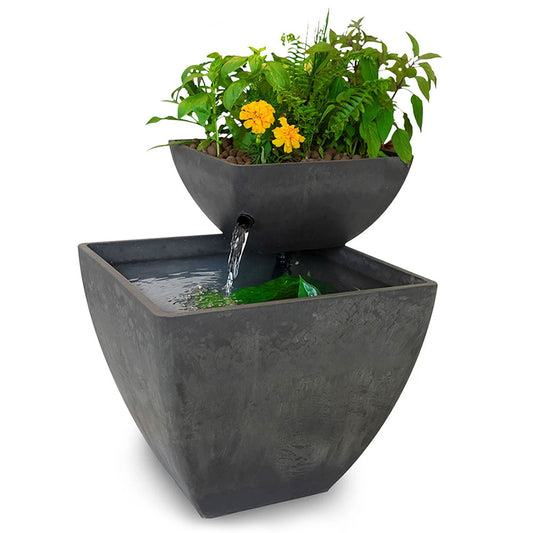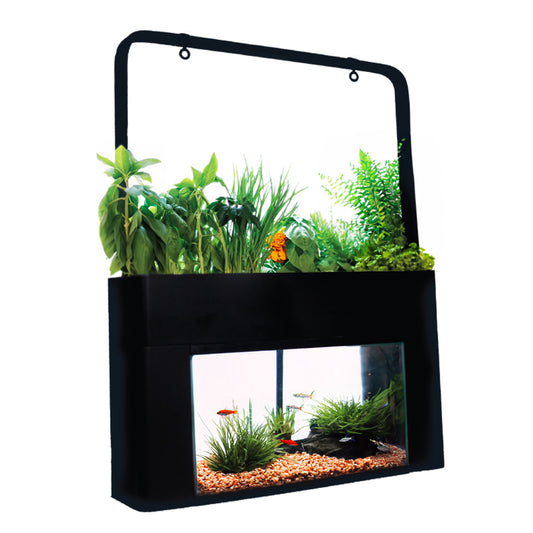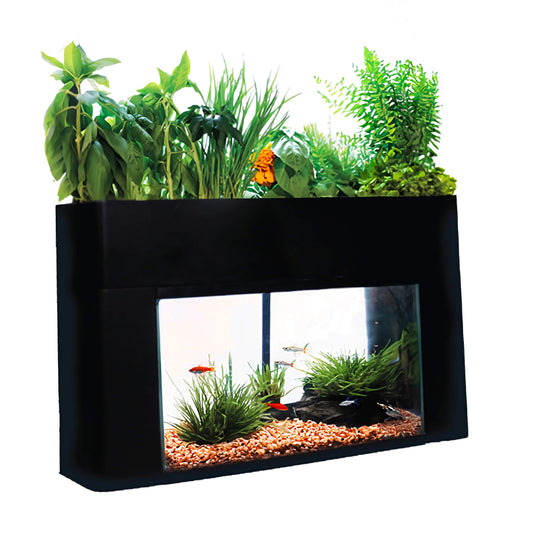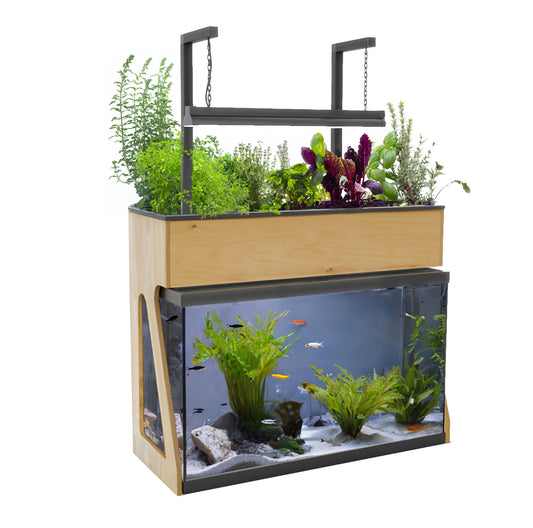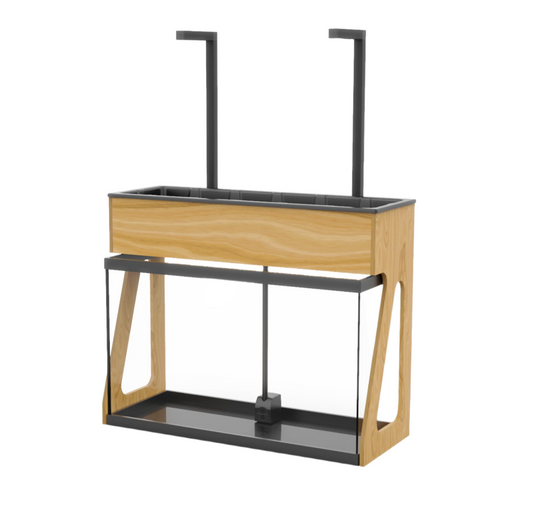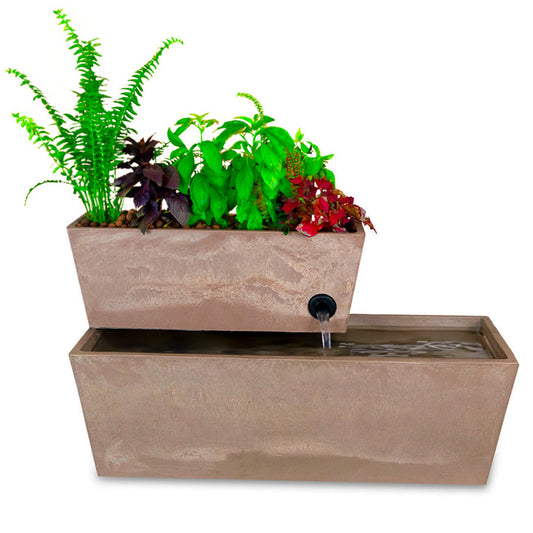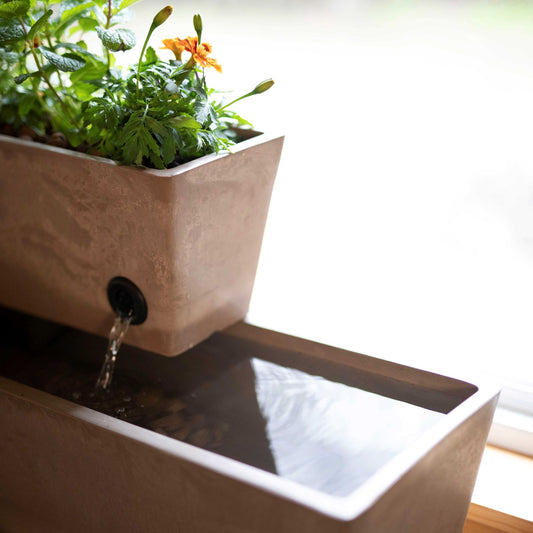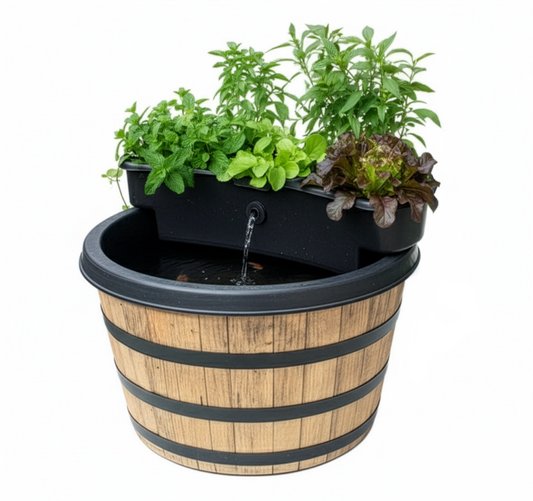What is aquaponics ?
- Fish produce waste
- Water and waste are pumped into the grow-bed above the aquarium hourly
- Bacteria in the grow-bed convert the waste into nutrients for the plants
- Clean water is cycled back into the aquarium after being filtered through the grow-bed

Garden Overview
Light Bar
Attach any 2ft grow light of your choice, or remove the light-bar and place your Garden near a sunny window

Grow bed
The grow-bed allows for ample space for biological filtration and room for all your favorite fresh plants
Clay Pebbles
Takes place of traditonal soil and acts as a support for the plants and roots. Also provides a surface area for nitrfying bacteria to colonize

Return Drain
Water is filled to a set level inside the grow-bed before being returned to the aquarium by two return drains
Pump
The pump is turned on by a timer every hour for 15 minutes, bringing water from the aquarium to the grow-bed. The pump is 9.5 Watts / 120 V

How It Works
Aquaponics involves breaking down toxic ammonia and turning it into nutritious plant food called nitrates using two types of nitrifying bacteria – nitrosomas and nitrospiras. When fish produce ammonia it attracts a type of bacteria called nitrosomas. These guys and gals convert the ammonia into nitrites – a compound even more toxic than ammonia. Thankfully, however, nitrites attract another type of bacteria called nitrospiras who then convert the nitrites into nitrates – excellent food for plants, and mostly harmless to fish. Once this has happened the aquaponic cycle is complete and, once stabilized, will ensure ammonia levels are kept at a minimum while providing maximum nutrition for the plants. Learn More
-
8 Gal. AquaSprouts Fountain
Regular price $168.95 USDRegular priceUnit price per$179.95 USDSale price $168.95 USDSale -
10 Gal. AquaSprouts Garden
Regular price $169.75 USDRegular priceUnit price per$189.95 USDSale price $169.75 USDSale -
29 Gal. AquaSprouts Garden
Regular price $334.95 USDRegular priceUnit price per$349.95 USDSale price $334.95 USDSale -
6 Gal. AquaSprouts Fountain
Regular price $159.45 USDRegular priceUnit price per$169.95 USDSale price $159.45 USDSale -
AquaSprouts Universal Pond Garden
Regular price $224.95 USDRegular priceUnit price per$249.95 USDSale price $224.95 USDSale
WHAT YOU SHOULD KNOW

WHAT CAN I LEARN FROM AQUASPROUTS ?
Our products are ideal not only for growing fresh herbs and plants, but also for teaching. Demonstrating a variety of concepts in chemistry, biology, and ecology. It’s an especially great tool for keeping kids engaged, a living model ecosystem that they can interact with as they watch the transformation of the energy in fish food into waste, plants, and ultimately herbs, greens, and even fruits for them to enjoy. Be sure to check out our blog for more articles on understanding the principles behind aquaponics and using your Garden to teach a variety of subjects!
IS THE GARDEN DIFFICULT TO MAINTAIN ?
We created the Garden specifically for beginners and those who are looking for an easy-to-use aquaponic system. The Garden doesn't require any tools nor do you need any previous aquaponics experience. In addition, we provide a written step-by-step guide to help you set up and maintain your Garden. Our team is also dedicated to providing the best customer service possible to assist anyone who may have questions or need help.
WHAT CAN I GROW ?
You can grow a variety of plants with AquaSprouts year-round! Some of the plants that we’ve found do very well include:
- Herbs like basil, oregano, mint, sage, parsley and dwarf varieties of rosemary
- Salad Greens such as lettuce, arugula, mesclun, and radicchio
- Microgreens like baby spinach, kale, and chard (all of these varieties can grow much larger, but harvesting them while they’re small and tender makes them great for eating fresh)
- Fruiting plants like eggplant, strawberries, many hot peppers, and container or patio-type tomatoes
- Flowers and ornamentals like marigolds (compact varieties), nasturtiums, petunias, zinnias, dianthus, impatiens, pansies and many more
In general, plants will be more productive with more light, but you should try to select plants that will grow well under the lighting conditions you have. If you add a strong grow-light to your Garden, you can attempt almost anything, but if you’re relying on ambient light or partial sunlight from a window, it’s a good idea to pick more shade-tolerant varieties, generally greens or ornamentals.
DO I NEED TO CLEAN THE AQUARIUM ?
In aquaponics, you don't have to clean your aquarium as often as you would in a traditional aquarium since the plants help to remove fish waste and excess nutrients from the water. However, cleaning the fish tank occasionally to remove uneaten food and debris, and performing partial water changes (usually 10-20%) on a quarterly basis, ensures optimal water quality and prevents mineral salt build-up.
In addition to maintaining the water quality, it's important to tend to your plants in the AquaSprouts system. Regular pruning helps promote healthy growth and prevents overcrowding, allowing the plants to thrive. You can also sow new seeds periodically to ensure a continuous harvest and variety of fresh produce.
While aquaponics is a self-cleaning and self-sustaining ecosystem that uses natural processes to clean the aquarium's water, it's still necessary to keep your aquaponic system in good condition to ensure its continued success and health.


